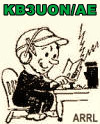|
<Previous
Next>
 4/24/2017 Update: The FCC's
ULS now shows my Amateur Extra license status! 4/24/2017 Update: The FCC's
ULS now shows my Amateur Extra license status!
Woo-hoo, I have finally achieved Ham radio license Nirvana! Reporting this on
World Amateur Radio Day seems appropriate. On Saturday, April
15, 2017 (tax day in the USA), I passed my
Amateur
Extra exam in the presence of three VEs (Volunteer Examiners) at the
Wattsburg Wireless Association
(of which I am a member) meeting room in Erie, Pennsylvania. Nearly seven years
have transpired since I took the Technician test in the same room on May 24, 2010.
My General license
test was taken at the Forsyth Amateur
Radio Club (FARC) meeting room in Winston Salem, North Carolina, on January
13, 2015. Until the FCC updates my record in the online Universal Licensing System
(ULS), my call sign will be
KB3UON/AE. A Ham friend of mine calls licensees like me who began
in the post Morse code requirement era "10-4 Good Buddy" Hams (ref CB radio operators).
Motivation for pursuing the Ham radio license goal was two-fold. First, I had
intended to get a license back while I was in the USAF (1978-1982), but never got
around to it; school, work, and family responsibilities got in the way (yeah, poor
excuse). By the time 2010 rolled around I figured time was running out (the family
gene pool does not include longevity), and besides (the second reason), it would
be a good way to review a lot of the electronics theory that was first learned lo
so many years ago. A lot of new information was also covered regarding FCC regulations,
spectrum assignment, operational bandwidths, modulation types, equipment, and procedures.
That was the part which took the most effort.
The entry level license is called "Technician," and contains a fair amount of
equation working, but it is as you would expect, mostly on the Ohm's Law level.
It's biggest challenge was getting over the threshold of entering an entirely new
realm (amateur radio). In my opinion, the General exam was the most difficult because
it required memorizing a huge number of frequencies, bandwidths, regulations, and
operational stuff. Both the Technician and General exams consisted of 35 question
pulled from a prepared pool of around 600. The Extra exam had 50 questions pulled from
a pool of around 725. A minimum passing score of 74% applied to all three. For each
test, I read the ARRL study manual from cover to cover, and then reviewed the entire
Q&A section at least half a dozen times, until I was confident that I could
answer every question correctly. That might be a bit extreme, but I really wanted
to know the material. The effort paid off by acing the exams. It was the same strategy
I used in college that resulted in achieving the highest GPA in my
BSEE graduating
class at University of Vermont (1989 UVM alum). Trust me, it wasn't because I'm
the sharpest pencil in the drawer, just that I'm willing to put forth maximum effort
to reach a meaningful goal (that, or maybe I was lucky to be in a class of not-too-bright
peers).
Now comes the decision whether to keep my current randomly assigned 2x3-format
call sign of
KB3UON, or apply for one of the extra special (get it?) call sign
formats reserved for Extra licensees. Sure, it's a vanity thing, but if it has been
earned, then why not? Below is info pulled from the FCC Universal Licensing System
(ULS) regarding NxM options, provided that the call sign you select is available.
Amateur Radio Call Signs
"A unique call sign is assigned to each amateur station during the processing
of its license. Each new sequentially assigned call sign is sequentially selected
from the alphabetized regional-group list for the licensee's operator class and mailing address. The mailing address must
be one where the licensee can receive mail delivery by the United States Postal
Service. The station is reassigned its same call sign upon renewal or modification of its license, unless the licensee
applies for a change to a new sequentially assigned or vanity call sign on FCC Form 605. Each call sign has a one letter
prefix (K, N, W) or a two letter prefix (AA-AL, KA-KZ, NA-NZ, WA-WZ) and a one,
two, or three letter suffix separated by a numeral (0-9) indicating the geographic
region. Two letter prefixes that are designated for regions 11-13 are not available
in regions 1-10. Certain combinations of letters are not used. When the call signs
in any regional-group list are exhausted, the selection is made from the next lower
group. The groups are:
| Group A - Amateur Extra Class |
| Primary stations licensed to Amateur Extra class operators. |
| Region |
Prefix |
Letters in Suffix |
| 1-10 |
K, N, or W, and two letter suffix; |
2 |
| two letter prefix with first letter A, N, K, or W |
1 |
| two letter prefix with first letter A |
2 |
| 11 |
AL, KL, NL, or WL |
1 |
| 12 |
KP, NP, or WP |
1 |
| 13 |
AH, KH, NH, or WH |
1 |
Note: "Call Me KB3UON/AE" is a lame allusion to Herman
Melville's famous opening line in Moby-Dick, "Call me Ishmael." Apologies to great classics sensitivities.
Posted April 18, 2017
|


























 "
"
